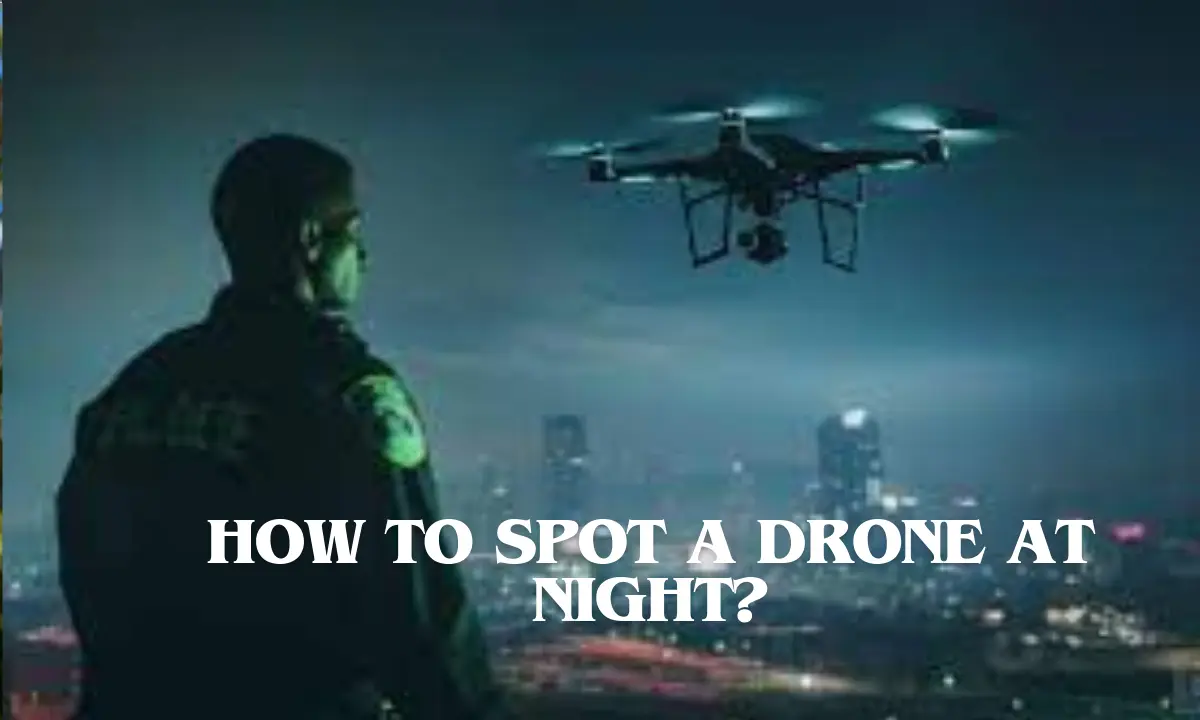How to spot a drone at night?: In today’s fast-paced world, drones have undeniably emerged as integral players, occupying a significant role in various aspects of our lives. From capturing breathtaking footage for movies, songs, and photos to assisting in a wide array of commercial and recreational applications, drones have revolutionized how we interact with technology. However, what remains intriguing is the prospect of spotting these enigmatic devices in the shroud of darkness.
This article will delves into the fascinating realm of nocturnal drone usage, shedding light on the methods to detect and identify these airborne marvels during nighttime operations. Understanding how and where a drone operates at night can provide valuable insights into its purpose and activities. Whether it’s ensuring privacy and security or simply satisfying our curiosity, being able to spot a drone at night can be a valuable skill to possess.
How to spot a drone at night?
So, if you’ve ever wondered about the unseen presence of drones in the darkened skies, or if you simply wish to stay informed and vigilant about their activities, this article will serve as your guide to understanding the captivating world of spotting drones at night. Prepare to unveil the mysteries and unlock the knowledge needed to navigate the nocturnal drone landscape with confidence and insight.
Importance of Spotting Drones at Night
Security Concerns
One of the primary reasons for spotting drones at night is to ensure security. Illegitimate drone activities, such as unauthorized surveillance or smuggling, can pose significant threats to public safety and national security.
Privacy Issues
Spotting drones in residential areas and private properties can help prevent invasions of privacy and protect individuals from unwarranted intrusions.
Air Traffic Safety
As drone usage increases, the risk of collisions with manned aircraft also rises. Detecting drones at night is essential for maintaining air traffic safety and preventing accidents.
Challenges in Spotting Drones at Night
Small Size and Low Visibility
Drones are often small and have minimal lighting, making them difficult to spot against the dark sky.
Use of Lights
While some drones have flashing lights, others might fly without any visible illumination, further complicating their detection.
Background Noise
The buzzing sound of drones can be masked by other nighttime sounds, making it challenging to rely on audio cues alone.
Fast Movement
Drones can move swiftly and change direction rapidly, making them challenging to track with the naked eye.
Effective Techniques for Spotting Drones at Night
Using Night Vision Devices
Night vision goggles and scopes amplify ambient light, enabling better visibility of drones in low-light conditions.
Thermal Imaging Cameras
Thermal cameras detect the heat signatures emitted by drones, making them highly effective for nighttime drone spotting.
Acoustic Sensors
Acoustic sensors can pick up the distinct sound signatures of drones, aiding in their identification.
Radar Systems
Radar technology can track the movement of drones, providing real-time data on their location.
Drone Detection Apps
Innovative smartphone apps use a combination of technologies to detect and identify drones based on their flight patterns and radio signals.
Safety Guidelines for Nighttime Drone Spotters
Legal Considerations
Before engaging in drone spotting, familiarize yourself with local laws and regulations concerning drone operations.
Personal Safety Measures
When spotting drones at night, ensure you are in a safe and well-lit location to avoid accidents and enhance visibility.
Reporting a Sighted Drone
Contacting Authorities
If you suspect a drone is engaged in illegal activities or poses a threat, report the sighting to the appropriate authorities.
Providing Information
Be prepared to provide relevant details such as the drone’s location, flight direction, and any noticeable markings.
Common Misidentifications
Birds
Birds in flight may occasionally be mistaken for drones due to their similar size and behavior.
Insects
Small flying insects can sometimes be misidentified as drones, especially in poorly lit conditions.
Planes or Helicopters
Distant planes or helicopters with blinking lights might be confused with drones, leading to false sightings.
How to Differentiate Drones from Other Objects
Light Patterns
Observe the drone’s light patterns, which can be unique to specific models and help distinguish them from other flying objects.
Flight Characteristics
Pay attention to the drone’s flight behavior, such as hovering or rapid changes in direction, which can aid in identification.
The Future of Drone Detection Technology
Advancements in AI and Machine Learning
Continued advancements in AI and machine learning algorithms will lead to more sophisticated drone detection systems.
Integration with Smart City Infrastructure
Drone detection technology is likely to be integrated into smart city infrastructure for enhanced surveillance and safety measures.
FAQs
Can drones be flown at night legally?
Yes, in many regions, drones can be flown at night as long as the operator complies with local regulations and obtains the necessary permits.
Do all drones have lights for nighttime visibility?
No, not all drones have lights for nighttime flights. Some models come with built-in lights, while others might lack visible illumination.
How far can thermal cameras detect drones at night?
The detection range of thermal cameras varies depending on the model and environmental conditions but can typically range from a few hundred meters to several kilometers.
Can drones be operated autonomously at night?
Yes, some drones can operate autonomously at night using GPS waypoints and pre-programmed flight paths.
Are drone detection apps reliable?
Drone detection apps have improved significantly and can be reliable, but their effectiveness may vary based on factors such as signal interference and the app’s capabilities.
Conclusion
Spotting drones at night is a crucial aspect of ensuring safety, security, and privacy in our ever-changing technological landscape. By using advanced detection techniques and adhering to safety guidelines, we can mitigate potential risks and foster a harmonious coexistence between drones and society. However, if you have any questions or queries regarding drones, feel free to ask in the comment section without any hesitation. Thank you for reading!

